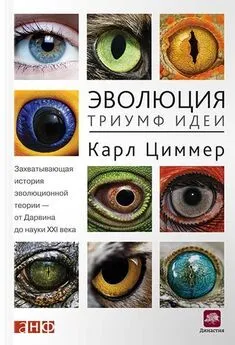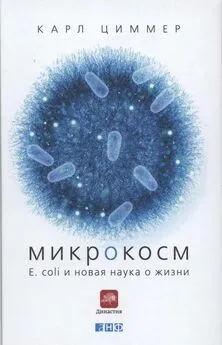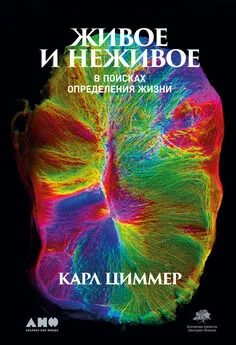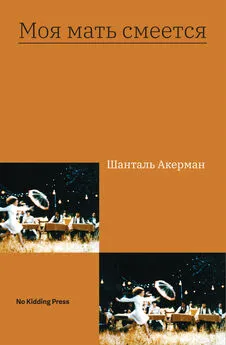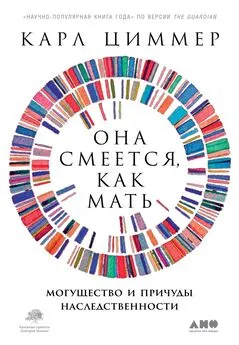Карл Циммер - Она смеется, как мать [Могущество и причуды наследственности] [litres]
- Название:Она смеется, как мать [Могущество и причуды наследственности] [litres]
- Автор:
- Жанр:
- Издательство:Литагент Альпина
- Год:2020
- Город:Москва
- ISBN:978-5-0013-9210-1
- Рейтинг:
- Избранное:Добавить в избранное
-
Отзывы:
-
Ваша оценка:
Карл Циммер - Она смеется, как мать [Могущество и причуды наследственности] [litres] краткое содержание
И культура, и традиции, география и экономика, технологии и то, в каком состоянии мы оставим планету, наконец. По мере развития науки появляется все больше способов вмешиваться в разные формы наследственности, что открывает потрясающие возможности, но одновременно ставит новые проблемы.
Технология CRISPR-Cas9, используемая для редактирования генома, генный драйв и создание яйцеклетки и сперматозоида из клеток кожи – список открытий растет с каждым днем, давая достаточно поводов для оптимизма… или беспокойства. В любом случае прежним мир уже не будет.
Карл Циммер знаменит своим умением рассказывать понятно. В этой важнейшей книге, которая основана на самых последних исследованиях и научных прорывах, автор снова доказал свое звание одного из лучших научных журналистов в мире.
Она смеется, как мать [Могущество и причуды наследственности] [litres] - читать онлайн бесплатно ознакомительный отрывок
Интервал:
Закладка:
________. 2010. A History of the Study of Human Growth. Cambridge: Cambridge University Press.
Taubes, Gary. 2013. “Rare Form of Dwarfism Protects Against Cancer.” Discover magazine, March 27. http://discovermagazine.com/2013/april/19double-edged-genes(accessed August 2, 2017).
Tavernise, Sabrina. 2014. “Shoukhrat Mitalipov’s Mitochondrial Manipulations.” New York Times, March 17.
Teich, A. H. 1984. “Heritability of Grain Yield, Plant Height and Test Weight of a Population of Winter Wheat Adapted to Southwestern Ontario.” Theoretical and Applied Genetics 68: 21–23.
Terman, Lewis Madison. 1922. “Were We Born That Way?” World’s Work 44: 655–60.
Teves, Sheila S., Luye An, Anders S. Hansen, Liangqi Xie, Xavier Darzacq, and Robert Tjian. 2016. “A Dynamic Mode of Mitotic Bookmarking by Transcription Factors.” bioRxiv. doi: 10.1101/066464.
Theis, Kevin R., Nolwenn M. Dheilly, Jonathan L. Klassen, Robert M. Brucker, John F. Baines, Thomas C. G. Bosch, John F. Cryan, and others. 2016. “Getting the Hologenome Concept Right: An Eco-Evolutionary Framework for Hosts and Their Microbiomes.” bioRxiv. doi: 10.1101/038596.
Thomas, Mark. 2013. “To Claim Someone Has Viking Ancestors Is No Better than Astrology.” Guardian, February 25.
Thomas, W. H. 1904. “Medical Treatment of Diabetes.” journal of the American Medical Association 42: 1451.
Thornton, Alex, and Katherine McAuliffe. 2006. “Teaching in Wild Meerkats.” Science 313: 227–29.
Thurtle, Phillip. 2007. “The Poetics of Life: Luther Burbank, Horticultural Novelties, and the Spaces of Heredity.” Literature and Medicine 26: 1–24.
Tibbies, J. A., and M. M. Cohen. 1986. “The Proteus Syndrome: The Elephant Man Diagnosed.” British Medical Journal 293: 683–85.
Tingley, Kim. 2014. “The Brave New World of Three-Parent I. V. F.” New York Times, June 27.
Tippett, Patricia. 1983. “Blood Group Chimeras: A Review.” Vox Sanguinis 44: 333–59.
Tissot, Tazzio, Audrey Arnal, Camille Jacqueline, Robert Poulin, Thierry Lefèvre, Frédéric Mery, François Renaud, and others. 2016. “Host Manipulation by Cancer Cells: Expectations, Facts, and Therapeutic Implications.” BioEssays 38: 276–85.
Tollefsbol, Trygve O., ed. 2014. Transgenerational Epigenetics Evidence and Debate. London: Academic Press.
Touati, Sandra A., and Katja Wassmann. 2016. “How Oocytes Try to Get It Right: Spindle Checkpoint Control in Meiosis.” Chromosoma 125: 321–35.
Traub, Amy, Laura Sullivan, Tatiana Meschede, Thomas Shapiro. 2017. The Asset Value of White Privilege: Understanding the Racial Wealth Gap. New York: Demos.
Treves, Frederick. 1923. The Elephant Man and Other Reminiscences. London: Cassell and Company.
Trzaskowski, M., J. Yang, P. M. Visscher, and R. Plomin. 2014a. “DNA Evidence for Strong Genetic Stability and Increasing Heritability of Intelligence from Age 7 to 12.” Molecular Psychiatry 19, no. 3. doi: l0.1038/mp.2012.191.
Trzaskowski, Maciej, Nicole Harlaar, Rosalind Arden, Eva Krapohl. Kaili Rimfeld, Andrew McMillan, Philip S. Dale, and Robert Plomin. 2014b. “Genetic Influence on Family Socioeconomic Status and Children’s Intelligence.” Intelligence 42. doi: 10.1016/j.intell.2013.11.002.
Tuchman, Arleen Marcia. 2011. “Diabetes and Race. A Historical Perspective.” American Journal of Public Health 101.no. 1. doi: 10.2105/AJPH.2010.202564.
Tucker, William H. 1994. The Science and Politics of Racial Research. Urbana: University of Illinois Press.
________. 2007. “Burt’s Separated Twins: The Larger Picture.” Journal of the History of the Behavioral Sciences 43: 81–86.
Tucker-Drob, Elliot M., and Timothy C. Bates. 2015. “Large Cross-National Differences in Gene x Socioeconomic Status Interaction on Intelligence.” Psychological Science 27: 138–49.
Turkheimer, Eric. 2012. “Genome Wide Association Studies of Behavior Are Social Science.” In Philosophy of Behavioral Biology. Edited by Kathryn S. Plaisance and Thomas Reydon. Springer Netherlands.
________. 2015. “Genetic Prediction.” Hastings Center Report 45, Suppl 1, S32S38.
Turkheimer, Eric, Andreana Haley, Mary Waldron, Brian D’Onofrio, and Irving I. Gottesman. 2003. “Socioeconomic Status Modifies Heritability of IQ in Young Children.” Psychological Science 14: 623–28.
Ujvari, Beata, Anne-Maree Pearse, Kate Swift, Pamela Hodson, Bobby Hua, Stephen Pyecroft, Robyn Taylor, and others. 2014. “Anthropogenic Selection Enhances Cancer Evolution in Tasmanian Devil Tumours.” Evolutionary Applications 7: 260–65.
________, Anthony T. Papenfuss, and Katherine Belov. 2016. “Transmissible Cancers in an Evolutionary Context.” BioEssays 38: S14S23.
________, Robert A. Gatenby, and Frédéric Thomas. 2016a. “The Evolutionary Ecology of Transmissible Cancers.” Infection, Genetics and Evolution 39: 293–303.
________. 2016b. “Transmissible Cancers, Are They More Common Than Thought?” Evolutionary Applications 9: 633–34.
Uller, Tobias, and Heikki Helantera. 2013. “Non-Genetic Inheritance in Evolutionary Theory: A Primer.” Non-Genetic Inheritance. doi: 10.2478/ngi-2013–0003.
Unckless, Robert, and Andrew Clark. 2015. “Driven to Extinction: On the Probability of Evolutionary Rescue from Sex-Ratio Meiotic Drive.” bioRxiv. doi: 10.1101/018820.
Urashima, Tadasu, Sadaki Asakuma, Fiame Leo, Kenji Fukuda, Michael Messer, and Olav T. Oftedal. 2012. “The Predominance of Type I Oligosaccharides Is a Feature Specific to Human Breast Milk.” Advances in Nutrition 3: 473S-482S.
Urban, Tim. 2015. “My Visit with Elon Musk at SpaceX.” Business Insider, May 11. http://www.businessinsider.com/my-visit-with-elon-musk-at-spacex-2015–5(accessed March 22, 2017).
US Department of Health and Human Services, Office of Minority Health. 2017. “Asthma and Hispanic Americans.” http://minorityhealth.hhs.gov/omh/browse.aspx?lvl=48ilvlid=60(accessed August 24, 2017).
US Holocaust Memorial Museum Photo Archives. 1944. “Soviets Exhume a Mass Grave in Zloczow Shortly After the Liberation.” Photograph 86588. Courtesy of Herman Lewinter. http://digitalassets.ushmm.org/photoarchives/detail.aspx?id=162768csearch=&index=l(accessed September 8, 2017).
US National Library of Medicine. 2017. “Tay-Sachs Disease.” Genetics Home Reference, October 10. http://ghr.nlm.nih.gov/condition/tay-sachs-disease.
“U. S. Panel Urges Testing at Birth.” 1961. New York Times, December 10, p. 80.
Vacca, Marcella, Floriana Delia Ragione, Francesco Scalabrl, and Maurizio D’Esposito. 2016. “X Inactivation and Reactivation in X–Linked Diseases.” Seminars in Cell & Developmental Biology 56: 78–87.
Valles, Sean A. 2012. “Lionel Penrose and the Concept of Normal Variation in Human Intelligence.” Studies in History and Philosophy of Science Part C: Studies in History and Philosophy of Biological and Biomedical Sciences 43: 281–89.
Vallot, Céline, Jean-François Ouimette, and Claire Rougeulle. 2016. “Establishment of X Chromosome Inactivation and Epigenomic Features of the Inactive X Depend on Cellular Contexts.” BioEssays 38. doi: 10.1002/bies.201600121.
Van der Pas, Peter. 1970. “The Correspondence of Hugo de Vries and Charles Darwin.” Janus 57: 173–213.
Van Dijk, Bob A., Dorret I. Boomsma, and Achile J. M. de Man. 1996. “Blood Group Chimerism in Human Multiple Births Is Not Rare.” American Journal of Medical Genetics 61: 264–68.
Van Dijk, Peter J., and Т. H. Noel Ellis. 2016. “The Full Breadth of Mendel’s Genetics.” Genetics 204: 1327–36.
Van Eenennaam, Alison L., Kent A. Weigel, Amy E. Young, Matthew A. Cleveland, and Jack C. M. Dekkers. 2014. “Applied Animal Genomics: Results from the Field.” Annual Review of Animal Biosciences 2: 105–39.
Van Lookeren Campagne, Menno, Erich C. Strauss, and Brian L. Yaspan. 2016. “Age-Related Macular Degeneration: Complement in Action.” Immunobiology 221: 733–39.
Vanneste, Evelyne, Thierry Voet, Cédric Le Caignec, Michèle Ampe, Peter Konings, Cindy Melotte. Sophie Debrock, and others. 2009. “Chromosome Instability Is Common in Human Cleavage-Stage Embryos.” Nature Medicine 15: 577–83.
Van Opstal, Edward J., and Seth R. Bordenstein. 2015. “Rethinking Heritability of the Microbiome.” Science 349: 1172–73.
Varney, Robin L., and Mohamed A. F. Noor. 2010. “The Scuttle Fly.” Current Biology 20: R466R467.
Vermont Historical Society. “William Jarvis & the Merino Sheep Craze.” http://vcrmonthistory.org/educate/online-resources/an-era-of-great-change/work-changing-markets/william-jarvis-s-merino-sheep(accessed August 6, 2017).
Vernot, Benjamin, Serena Tucci, Janet Kelso, Joshua G. Schraiber, Aaron B. Wolf, Rachel M. Gittelman, Michael Dannemann, and others. 2016. “Excavating Neandertal and Denisovan DNA from the Genomes of Melanesian Individuals.” Science 352: 1172–73.
Villa, Paola, and Wil Roebroeks. 2014. “Neandertal Demise: An Archaeological Analysis of the Modern Human Superiority Complex.” PLOS One 9: e96424.
The Vineland Training School. 1896. 8th Annual Report. Vineland, NJ.
________. 1898. 10th Annual Report. Vineland, NJ.
________. 1899. 11th Annual Report. Vineland, NJ.
________. 1906. 18th Annual Report. Vineland, NJ.
________. 1907. 19th Annual Report. Vineland, NJ.
________. 1909. 21st Annual Report. Vineland, NJ.
________. 1910. 22nd Annual Report. Vineland, NJ.
Vines, Gail. 1997. “Mary Lyon: Quiet Battler.” Current Biology 7: R269.
Vinkhuyzen, Anna A. E., Naomi R. Wray, Jian Yang, Michael E. Goddard, and Peter M. Visscher. 2013. “Estimation and Partition of Heritability in Human Populations Using Whole-Genome Analysis Methods.” Annual Review of Genetics 47: 75–95.
Vinovskis, Maris. 2008. The Birth of Head Start: Preschool Education Policies in the Kennedy and Johnson Administrations. Chicago: University of Chicago Press.
Visscher, Peter M., Brian McEvoy, and Jian Yang. 2010. “From Galton to GWAS: Quantitative Genetics of Human Height.” Genetics Research 92: 371–79.
Visscher, Peter M., Matthew A. Brown, Mark I. McCarthy, and Jian Yang. 2012. “Five Years of GWAS Discovery.” American Journal of Human Genetics 90: 7–24.
________, Sarah E. Medland, Manuel A. R. Ferreira, Katherine I. Morley, Gu Zhu, Belinda K. Cornes, Grant W. Montgomery, and Nicholas G. Martin. 2006. “Assumption-Free Estimation of Heritability from Genome-Wide Identity-by-Descent Sharing between Full Siblings.” PLOS Genetics 2x41.
________, Stuart Macgregor, Beben Benyamin, Gu Zhu, Scott Gordon, Sarah Medland, William G. Hill, and others, 2007. “Genome Partitioning of Genetic Variation for Height from 11, 214 Sibling Pairs.” American Journal of Human Genetics 81: 1104–10.
de Vries, Hugo. 1904. “The Aim of Experimental Evolution.” Carnegie Institution of Washington Yearbook 3: 39–49.
________. 1905. “A Visit to Luther Burbank.” Popular Science Monthly, August.
Waddington, С. H. 1957. The Strategy of the Genes: A Discussion of Some Aspects of Theoretical Biology. London: George Allen & Unwin.
Читать дальшеИнтервал:
Закладка:
![Обложка книги Карл Циммер - Она смеется, как мать [Могущество и причуды наследственности] [litres]](/books/1075049/karl-cimmer-ona-smeetsya-kak-mat-moguchestvo-i-pr.webp)

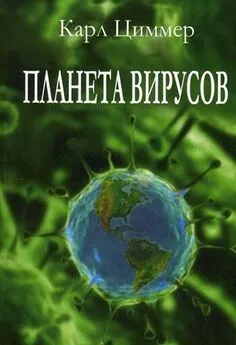
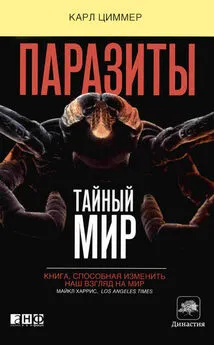

![Карл Циммер - Паразит – царь природы [Тайный мир самых опасных существ на Земле] [litres]](/books/1067054/karl-cimmer-parazit-car-prirody-tajnyj-mir-sam.webp)
